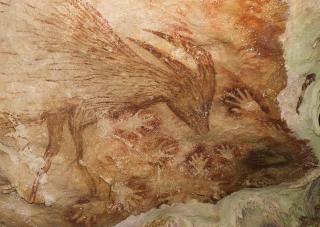
A hand painted in an Indonesian cave dates to at least 39,900 years ago, making it among the oldest such images in the world, archaeologists reported Wednesday in a study that rewrites the history of art.
The discovery on the island of Sulawesi vastly expands the geography of the first cave artists, who were long thought to have appeared in prehistoric Europe around that time. Reported in the journal Nature, the cave art includes stencils of hands and a painting of a babirusa, or "pig-deer," which may be the world's oldest figurative art.
National Geographic
Those hand silhouettes were made some 40,000 years ago.
Until recently, they were thought to be much "newer." It was not until a new process of dating was available that anyone suspected that the times of the cave paintings in Indonesia matched -- or even pre-dated -- those in Europe.
The full Nature article is fire-walled, but an excerpt includes this incredible video.
(h/t NonnyO)
And here is the summary:
Archaeologists have long been puzzled by the appearance in Europe ~40–35 thousand years (kyr) ago of a rich corpus of sophisticated artworks, including parietal art (that is, paintings, drawings and engravings on immobile rock surfaces) and portable art (for example, carved figurines), and the absence or scarcity of equivalent, well-dated evidence elsewhere, especially along early human migration routes in South Asia and the Far East, including Wallacea and Australia, where modern humans (Homo sapiens) were established by 50 kyr ago. Here, using uranium-series dating of coralloid speleothems directly associated with 12 human hand stencils and two figurative animal depictions from seven cave sites in the Maros karsts of Sulawesi, we show that rock art traditions on this Indonesian island are at least compatible in age with the oldest European art. The earliest dated image from Maros, with a minimum age of 39.9 kyr, is now the oldest known hand stencil in the world. In addition, a painting of a babirusa (‘pig-deer’) made at least 35.4 kyr ago is among the earliest dated figurative depictions worldwide, if not the earliest one. Among the implications, it can now be demonstrated that humans were producing rock art by ~40 kyr ago at opposite ends of the Pleistocene Eurasian world.
Nature
These paintings have caused scientists to rethink “the history of human creativity.”
NPR had more tonight on All Things Considered:
"Until now, we've always believed that cave painting was part of a suite of complex symbolic behavior that humans invented in Europe," says archaeologist Alistair Pike of the University of Southampton in the United Kingdom. "This is actually showing that it's highly unlikely that the origin of painting caves was in Europe."
(snip)
Figurative artwork depicting animals has been found on stone slabs in a rock shelter known as Apollo 11 in Namibia, points out Alison Brooks of George Washington University, who says these images were made more than 30,000 years ago.
"What this suggests is that this whole ability to make these things and possibly the tradition of making them is part of the cultural repertoire of the people who left Africa," says Brooks. She says that the paintings in Indonesia are very similar to images seen in Europe — for example, the babirusa in profile, with hair, is similar to European depictions of hairy mammoths.
But the Indonesian animals have stick legs and feet, instead of more detailed limbs. And there's a hint of a red line that might depict the ground surface of the land that the animal is standing on, which is not found in other places.
"There are some things that are a little bit different about this," says Brooks, though "it does seem to be that it's part of the tradition."
NPR
This has been an astonishing and amazing day in the fields of anthropology, migration, art and human development.
And what I wonder about is this: whose hands were those?


